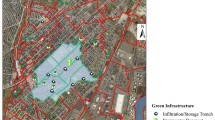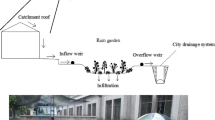Abstract
Against a background of frequent urban flooding and the construction of new so-called “sponge cities” in China, this paper proposes a scheme for Successive Low-Impact Development Rainwater Systems (SLIDRS) in residential areas. The Shizhuang community in China is used as a case study site for a simulated SLIDRS infrastructure based on a stormwater management model (SWMM). Peak flows, peak delay times, infiltration, and water conservation were simulated and analyzed under three different scenarios: pre-development conditions, residential development with the use of a conventional sewer system, and residential development with the use of SLIDRS. The differing effects of development under the following four rainfall conditions were evaluated: 1-year, 2-year, 5-year, and 10-year return periods. Results showed that SLIDRS can decrease peak flows and total runoff volume effectively. Moreover, peak flow times were delayed compared with those resulting from the conventional technology. Therefore, SLIDRS may represent a viable strategy towards solving local urban flooding problems.








Similar content being viewed by others

Change history
02 February 2019
In the original publication, the Figs. 5 and 7 are published incorrectly. The correct figures are given below:
References
Baek SS, Choi DH, Jung JW, Lee HJ, Lee H, Yoon KS, Cho KH (2015) Optimizing low impact development (LID) for stormwater runoff treatment in urban area, Korea: experimental and modeling approach. Water Res 86:122–131
Bamba I, Azuma M, Hamada N, Kubo H, Isoda N (2014) Case study of airborne fungi according to air temperature and relative humidity in houses with semi-basements adjacent to a forested hillside. J Biocontrol Sci 19(1):1–9
Campisano A, Di Liberto D, Modica C, Reitano S (2014) Potential for peak flow reduction by rainwater harvesting tanks. Procedia Eng 89:1507–1514
Cen GP, Shen J, Van RS (1998) Urban design storm type research. J Adv Water Sci 9(1):42–47
Dietz ME, Clausen JC (2005) A field evaluation of raingarden flow and pollutant treatment. Water Air Soil Pollut 167:123–138
Du JK, Qian L, Rui HY, Zuo TH, Zheng DP, Xu YP, Xu C-Y (2012) Assessing the effects of urbanization on annual runoff and flood events using an integrated hydrological modeling system for Qinhuai River basin, China. J Hydrol 464–465:127–139
Du SQ, Shi PJ, Van Rompaey A, Wen JH (2015) Quantifying the impact of impervious surface location on flood peak discharge in Urban Areas. J Nat Haz 76(3):1457–1471
Hashemi S, Han M, Kim T (2015a) Identification of urine scale problems in urinals and the solution using rainwater. J Water Sanit Hyg Dev 5(2):322–329. https://doi.org/10.2166/washdev.2015.100
Hashemi S, Han M, Kim T (2015b) The effect of material and flushing water type on urine scale formation. Water Sci Technol 72(11):2027–2033. https://doi.org/10.2166/wst.2015.422
Hashemi S, Han M (2017a) Control of urine odor in different sanitation practices and its implication on water saving. J Water Sanit Hyg Dev 7(1):156–162. https://doi.org/10.2166/washdev.2017.094
Hashemi S, Han M (2017b) Methods for controlling stored urine odor in resource-oriented sanitation. J Water Sanit Hyg Dev 7(3):507–514. https://doi.org/10.2166/washdev.2017.098
Hashemi S (2018) Study on the resource circulated sanitation (RCS) using nitrifying microorganisms. Dissertation, Seoul National University
Hoffa CR, Prokopy LS, Babin N, Turner AJ (2014) Adoption, maintenance and diffusion of stormwater best management practices: rain barrels. In: Proceedings of the Summer Undergraduate Research Fellowship (SURF) Symposium, 7 August 2014, Purdue University, West Lafayette, Indiana
Ishimatsu K, Ito K, Mitani Y, Tanaka Y, Sugahara T, Naka Y (2017) Use of rain gardens for stormwater management in urban design and planning. J Landsc Ecol Eng 13(1):205–212
Ismail AF, Sapari N, Abdul Wahab MM (2014) Vegetative swale for treatment of stormwater runoff from construction site. Pertanika J Sci Technol 22:55–64
Javaheri A, Babbar-Sebens M (2014) On comparison of peak flow reductions, flood inundation maps, and velocity maps in evaluating effects of restored wetlands on channel flooding. Ecol Eng 73:132–145
Jennings AA, Adeel AA, Hopkins A, Litofsky AL, Wellstead SW (2013) Rain Barrel—Urban garden stormwater management performance. J Environ Eng 139(5):757–765
Jia HF, Ma HT, Sun ZX, Yu SW, Ding YW, Liang Y (2014) A closed urban scenic river system using stormwater treated with LID-BMP technology in a revitalized historical district in China. Ecol Eng 71:448–457
Jia HF, Yao HR, Tang Y, Yu SL, Field R, Tafuri AN (2015) LID-BMPs planning for urban runoff control and the case study in China. J Environ Manag 149:65–76
Keifer CJ, Chu HH (1957) Synthetic storm pattern for drainage design. J Hydraul Div 83:1–25
Knight EMP, Hunt WF, Winston RJ (2013) Side-by-side evaluation of four level spreader–vegetated filter strips and a swale in eastern North Carolina. J Soil Water Conserv 68(1):60–72
Lee BY, Wei HY (2008) Building construction part 1. China Building Industry Press, Beijing, pp 187–189
Lee JY, Lee MJ, Han MY (2015) A pilot study to evaluate runoff quantity from green roofs. J Environ Manag 152:171–176
Liu D, Qin CQ (2009) Influence on rainfall run-off due to urbanization in Wuhan City of China, 182–184. https://doi.org/10.1109/ESIAT.2009.442
Miller JD, Kim H, Kjeldsen TR, Packman J, Grebby S, Dearden R (2014) Assessing the impact of urbanization on storm runoff in a peri-urban catchment using historical change in impervious cover. J Hydrol 515:59–70
National Standard of the People’s Republic of China (2016) Code for design of outdoor wastewater engineering GB 50014 – 2006. Standardization Administration for the People’s Republic of China, Beijing
Ogden FL, Raj Pradhan N, Downer CW, Zahner JA (2011) Relative importance of impervious area, drainage density, width function, and subsurface storm drainage on flood runoff from an Urbanized catchment. Water Resour Res 47(12):1–12
Qin HP, Li ZX, Fu GT (2013) The effects of low impact development on urban flooding under different rainfall characteristics. J Environ Manag 129:577–585
Rossman LA (2010) Storm water management model user’s Manual —Version 5.0, United States Environmental Protection Agency, EPA/600/R-05/040
Seo YW, Choi NJ, Park DY (2012) Effect of connecting rain barrels on the storage size reduction. Hydrol Process 26:3538–3551
Sin J, Jun C, Zhu JH, Yoo C (2014) Evaluation of flood runoff reduction effect of LID (Low Impact Development) based on the decrease in CN: case studies from Gimcheon Pyeonghwa district, Korea. 12th International Conference on Computing and Control for the Water Industry, CCWI2013, Procedia Eng 70:1531–1538
Tian SG (2013) Effect analysis on rainwater conservation benefit of concave herbaceous field in Jinan City. J Adv Mat Res 726–731:3685–3689
Van Woert ND, Rowe DB, Andresen JA, Rugh CL, Fernandez RT, Xiao L (2005) Green roof stormwater retention: effects of roof surface, slope, and media depth. J Environ Qual 34:1036–1044
Wang BK (2011) Infrastructure programming for the urban planning. Tianjin University Press, Tianjin, pp 56–65
Yang HB, Dick WA, McCoy EL, Phelan PL, Grewal PS (2013) Field evaluation of a new biphasic rain garden for stormwater flow management and pollutant removal. Ecol Eng 54:22–31
Acknowledgements
This research was supported by: Research on the Framework and Key Technologies of Spongy City Planning System Based on SWMM Hydrological Model through Tianjin University Research Institute of Urban Planning [Grant number 2017GKF-0787]; Science and Technology Support Program through the National Research Foundation of Korea (NRF) funded by the Ministry of Science and ICT (MSIT) [Grant number NRF-2018K1A3A9A04000025]; Korea Environment Industry & Technology Institute (KEITI) through Public Technology Program based on Environmental Policy, funded by Korea Ministry of Environment (MOE) [Grant numbers 2018000200001 and 2016000200007]; Korea Ministry of Environment (MOE) as Waste to Energy - Recycling Human Resource Development Project; The Institute of Construction and Environmental Engineering at Seoul National University. The authors wish to express their gratitude for the support.
Author information
Authors and Affiliations
Corresponding author
Ethics declarations
Conflict of interest
The authors declare that they have no conflict of interest.
Additional information
Publisher’s Note
Springer Nature remains neutral with regard to jurisdictional claims in published maps and institutional affiliations.
This article is a part of Topical Collection in Environmental Earth Sciences on Water Sustainability: A Spectrum of Innovative Technology and Remediation Methods, edited by Dr. Derek Kim, Dr. Kwang-Ho Choo, and Dr. Jeonghwan Kim.
The original version of this article was revised: In the original publication, figures 5 and 7 were published wrong. The correct figures are updated now.
Rights and permissions
About this article
Cite this article
Miao, ZT., Han, M. & Hashemi, S. The effect of successive low-impact development rainwater systems on peak flow reduction in residential areas of Shizhuang, China. Environ Earth Sci 78, 51 (2019). https://doi.org/10.1007/s12665-018-8016-z
Received:
Accepted:
Published:
DOI: https://doi.org/10.1007/s12665-018-8016-z



